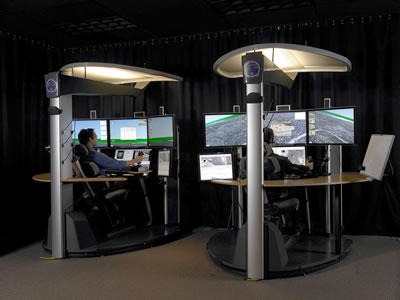A new “cockpit” designed specifically for UAV pilots unveiled yesterday by Raytheon promises to improve operational efficiency and flight safety of unmanned aerial systems. The new cockpit, called Universal Control System (UCS) is designed to simplify control of multiple unmanned aerial systems, by improving situational awareness and ability to control multiple unmanned platforms. The system uses open architecture to control multiple platforms and sensors utilizing STANAG 4586 compliant systems, configured as a ground based “glass cockpit”. Raytheon is confident that the new cockpit can improve the flight safety of unmanned systems, particularly of piloted UAVs such as the USAF Predator.
A 2004 study by the Federal Aviation Administration, “A Summary of Unmanned Aircraft Accident/Incident Data: Human Factors Implications,” stated that ” … a common theme across many of the mishaps reported involved a problem with the command interface to the system.” The study also noted that “In the systems analyzed, human factors issues were present in 21 percent (Shadow) to 67 percent (Predator) of the accidents. The report recommended that “human factors issues … can be identified and addressed.” Raytheon is addressing this issue with the Universal Control System (UCS), promising to improve operational efficiency and flight safety of unmanned aerial systems by improving situational awareness and ability to control multiple unmanned platforms.
“Aircrews today need UCS superior control interfaces and situational awareness, which will dramatically improve the combat effectiveness of pilot and sensor operators,” said Michael Keaton, former commander of a U.S. Air Force Predator squadron who is now working for Raytheon. “We developed the essential tools and technology needed to bring UCS to fruition, and I believe this is the only UAS control system on the market designed specifically around the operator to enhance combat operations.”
“We broke down the operator’s tasks and objectives and constructed a system built entirely around them, rather than building the system around the air vehicle first, without input from the operators. Improvements included adding a wrap-around display to enhance operator effectiveness” Says Mark Bigham, business development director for Raytheon’s Intelligence and Information Systems. “We wanted to put operators in the UAS ‘cockpit’ virtually and dramatically enhance their situational awareness. UCS operators will have better situational awareness than any manned platform, which dramatically improves safety.”
Leveraging the investments made in advanced gaming technologies Raytheon’s UCS uses an intuitive interface, enabling effective learning and reduced training requirements mastering UAS missions. Raytheon designed and developed the UCS to meet operator demands and decrease human factors issues when operating a UAS. The enhanced operating system addresses ergonomic concerns and caters to the needs of the operators to help them perform their jobs more effectively.
In addition, the system gives the operator the option of standing or sitting and provides flexibility in controlling multiple functions. Moreover, the technology provides a safer work environment for operators, keeping their minds more focused to perform their missions more effectively and safer. The UCS system can control multiple dissimilar UASs simultaneously, using software designed and developed by Raytheon.





















